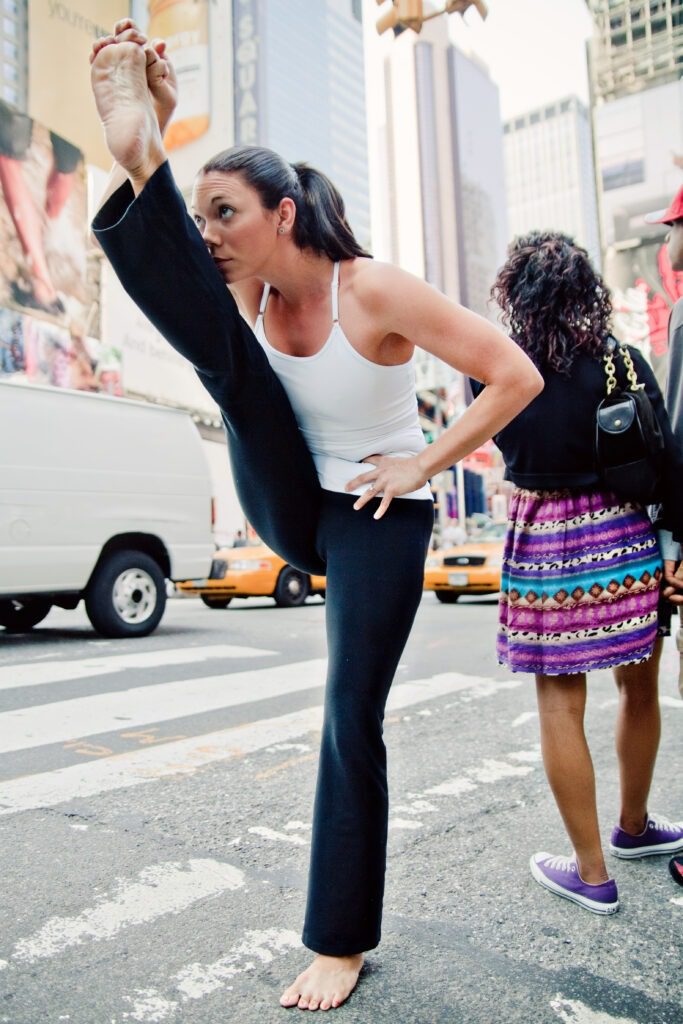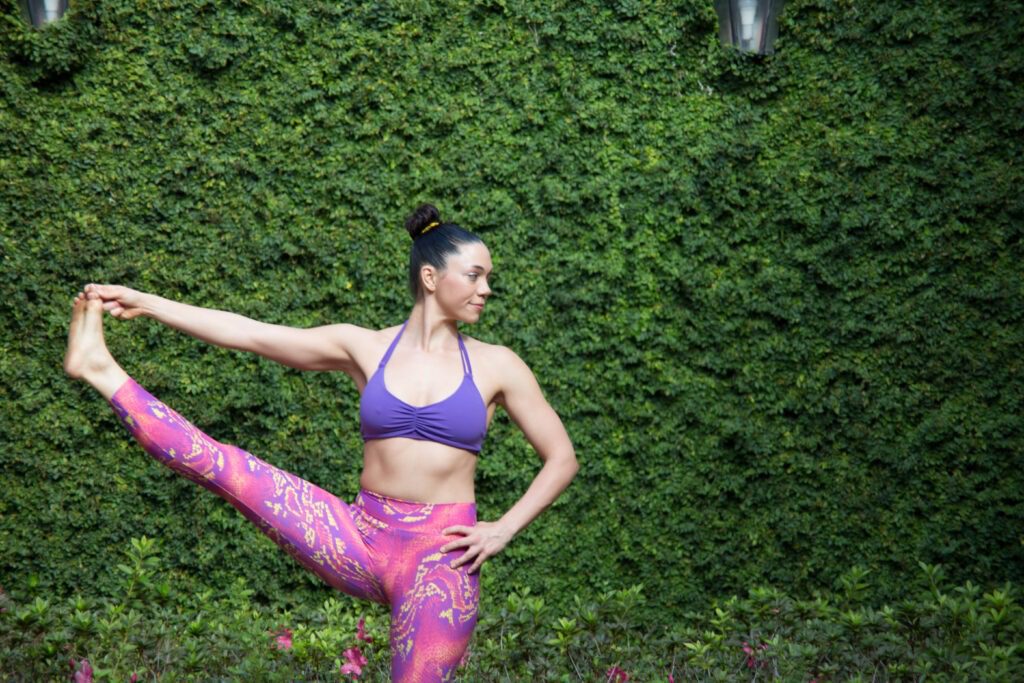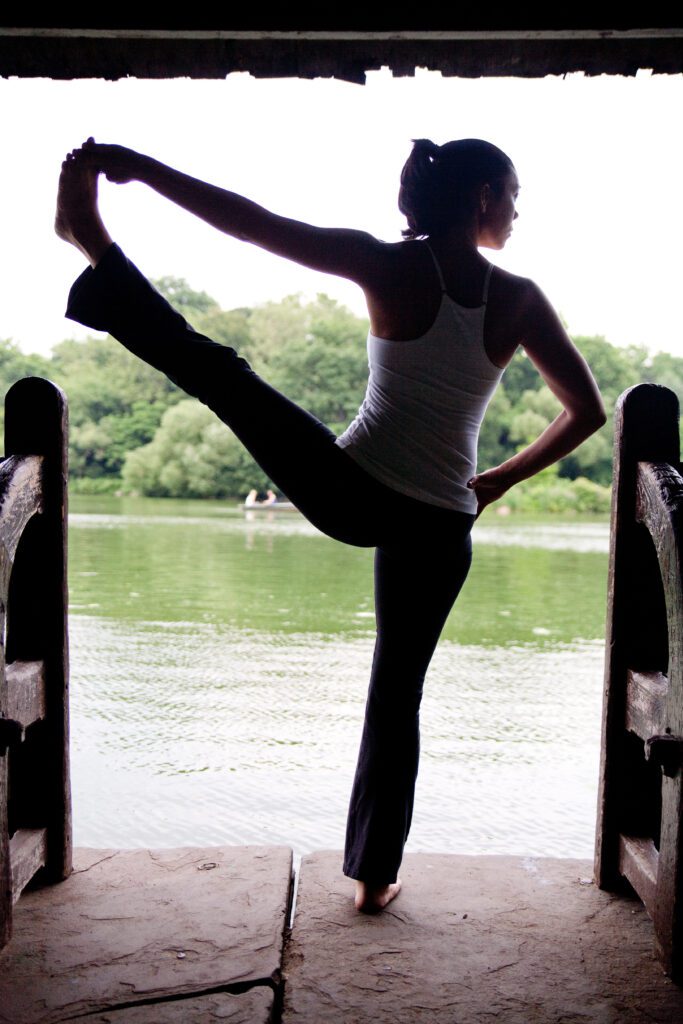Ashtanga yoga is a dynamic and physically demanding practice that combines breath with movement. One of the challenging poses in the Ashtanga yoga sequence is Utthita Hasta Padangusthasana. Known in English as Extended Hand-to-Big-Toe Pose. This pose requires strength, flexibility, and balance. With consistent practice, it can be mastered. In this blog post, we will provide you with benefits, contraindications, modifications and step-by-step instructions to help you confidently practice Utthita Hasta Padangusthasana.

BENEFITS
Utthita Hasta Padangusthasana offers a multitude of benefits for both the body and mind. Some of the key benefits of practicing this pose include:
- Improved balance and stability: Utthita Hasta Padangusthasana challenges your balance as you balance on one leg while extending the other leg. Regular practice can help improve your sense of balance and stability, both on and off the yoga mat.
- Increased flexibility: This pose requires flexibility in the hamstrings, hips, and groin. Regular practice can help stretch and strengthen these areas, improving your overall flexibility and mobility.
- Strengthened core and leg muscles: As you balance on one leg and extend the other leg, you engage your core and leg muscles, including the quadriceps, hamstrings, and glutes. Regular practice can help strengthen these muscles, enhancing your overall physical strength and stability.
- Improved focus and concentration: Utthita Hasta Padangusthasana requires focus and concentration to maintain balance and stability. Regular practice can help improve your mental focus and concentration, bringing a sense of mindfulness to your practice.
- Enhanced body awareness: This pose requires you to be aware of your body alignment, balance, and breath. Regular practice can help develop a heightened sense of body awareness, allowing you to better understand and connect with your body.
Incorporating Utthita Hasta Padangusthasana into your regular yoga practice can provide you with a wide range of physical and mental benefits. Remember to practice with patience, listen to your body, and modify as needed to avoid any strain or injury.
Contraindications:
- Recent or chronic injuries to the hips, knees, or ankles: If you have any recent or chronic injuries to the hips, knees, or ankles, it’s important to avoid or modify Utthita Hasta Padangusthasana to avoid further strain or injury. Always listen to your body and work within your comfort level.
- High blood pressure: Utthita Hasta Padangusthasana requires you to hold your leg up for an extended period of time, which can increase blood pressure. If you have high blood pressure, it’s advisable to practice this pose with caution and avoid holding the leg up for too long.
- Vertigo or dizziness: The balancing aspect of Utthita Hasta Padangusthasana can trigger vertigo or dizziness in some individuals. If you experience these symptoms, it’s best to avoid or modify the pose to avoid discomfort or risk of falling.
As with any yoga practice, it’s important to consult with a qualified yoga instructor or healthcare professional if you have any concerns or medical conditions before attempting Utthita Hasta Padangusthasana or any other yoga pose. They can provide you with personalized guidance and modifications to suit your individual needs and ensure safe and effective practice. Always practice mindfully, listen to your body, and respect your limits to avoid any strain or injury during your yoga practice.

Tap here to watch a step-by-step tutorial video of Utthita Hasta Padangusthasana
Step-by-Step Instructions for the Full Expression of Utthita Hasta Padangusthasana
Ekam – Inhale:
Standing in Samasthithi, inhale your right arm out directly in front of you. Simultaneously, lift the right leg straight up. On the same inhale, catch the big toe with your thumb, index and middle finger
Dve – Exhale:
Exhale your torso over your extended right leg as you bend your right elbow to ring your torso towards your leg. Work with tensegrity or oppositions of force to maintain your balance. To do that, work to press your pelvis backwards as you extend your upper body forwards. Gaze to the big toe of your right foot (Padayoragra Drishti). Breathe here for 5 deep breaths.
Trini – Inhale:
Inhale as you straighten your right arm and bring your torso upright back to standing position.
Catvari – Exhale, 5 Breaths:
Still holding your fingers to your big toe, exhale as you take your right leg out to the right. Gaze over the left shoulder (Parsva Drishti). Stay here for five deep breaths.
Panca – Inhale:
Bring your right leg forward again. Your right arms stays extended, the left hand on your hip
Sat – Exhale:
Exhale fold your torso over your extended right leg.
Santa – Inhale, Exhale, 5 breaths:
Inhale bring your torso back up to standing position and then exhale your hands to your his. Hold your leg upright in this position with a neutral spine. Use your deep core muscles. Stay here for five deep breaths.
Ashtau – Caturdasa 8 to 14:
At the end of the fifth exhale, lower the right leg down. Then repeat the entire flow of movement (Vinyāsa 1 to 7) on the left side.
Like any yoga pose, Utthita Hasta Padangusthasana requires consistent practice to master. Incorporate it into your regular yoga practice, and be patient with yourself as you work towards improving your strength, flexibility, and balance.
Tap here to watch a step-by-step tutorial video of Utthita Hasta Padangusthasana
Modifications
Use a strap or a towel:
If you have limited flexibility in your hamstrings or cannot reach your big toe comfortably, you can loop a strap or a towel around the ball of your foot. Hold the ends of the strap with your hand and use it to gently pull your leg towards your chest, while keeping the other hand on your hip for support. This will help you maintain the correct alignment and still experience the benefits of the pose without straining.
Use a wall for support:
If you are struggling with balance, you can practice this pose next to a wall for support. Stand with your back against the wall and perform the pose with your free hand resting lightly on the wall. This will provide stability and help you focus on the alignment of your leg and torso without worrying about losing balance.
Bend your knee:
If you have tight hamstrings or limited flexibility in your hips, you can bend your knee slightly in Utthita Hasta Padangusthasana. This will reduce the intensity of the stretch and make the pose more accessible. Remember to keep your back straight and engage your core to maintain stability.
Place your foot on a block or elevated surface:
If reaching for your big toe is challenging, you can place your foot on a block or an elevated surface, such as a folded blanket or bolster. This will raise the height of your foot, making it easier to reach and hold onto, while maintaining proper alignment in your spine and hips.
Practice against a wall:
Another modification for Utthita Hasta Padangusthasana is to perform the pose with your back against a wall. Start by standing close to a wall and extend your leg forward, resting your heel against the wall. This will provide additional support and stability as you work on improving your balance and flexibility.

Remember, it’s important to listen to your body and only go as far as your comfortable range of motion allows. Yoga is not about pushing yourself beyond your limits, but rather finding a balance between effort and ease. Always practice mindfully and with awareness, and consult with a qualified yoga instructor for guidance and modifications that suit your individual needs.
Utthita Hasta Padangusthasana is a challenging yet rewarding pose in the Ashtanga yoga sequence. With consistent practice, you can master this pose and reap its numerous benefits. Follow the step-by-step instructions provided in this blog post, practice regularly, and enjoy the journey of exploring and deepening your yoga practice with Utthita Hasta Padangusthasana.
Tap here to watch a step-by-step tutorial video of Utthita Hasta Padangusthasana
Practice with The Yoga Shala
If you want to join us for LIVE classes, The Yoga Shala offers virtual and in person classes every weekday morning. Owner, Krista Shirley, also offers virtual or in person private sessions (Yoga, Meditation, Breath-work, Nutrition, Life Coaching and Mentorship). Visit theyogashala.org for details.
Be sure to signup for our newsletter to stay on top of local events and classes, Nysa products sales, new offerings, new products and more!
We hope you find this video series helpful to you in creating or maintaining your yoga practice!

About Krista:
Krista Shirley is a level II authorized Ashtanga Yoga teacher. She is deeply passionate about sharing these teachings with all who wish to learn.
If you want to join Krista in person she teaches daily classes at The Yoga Shala in Winter Park, Florida. She also offers virtual sessions in Yoga, Meditation, Breath-work, Nutrition, Life Coaching and Mentorship. Check out www.theyogashala.org for more details.
If you do not live in Central Florida and want to find an authorized teacher in your area, check out our teacher, Sharath Jois’ website, for a list of all teachers authorized and certified by his yoga centre in India.
❤️SHOP MERCHANDISE:
Nysa Products
❤️LET’S BE SOCIAL:
Instagram: Krista Shirley Yoga
Instagram: The Yoga Shala
Facebook: The Yoga Shala
Facebook: KristaShirleyYoga
For other inquires please contact: [email protected]




